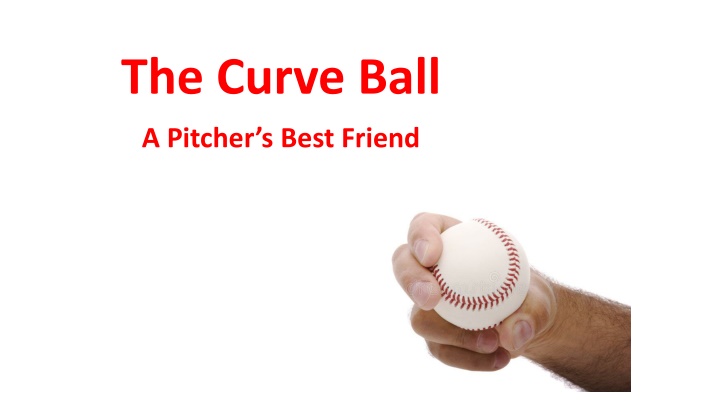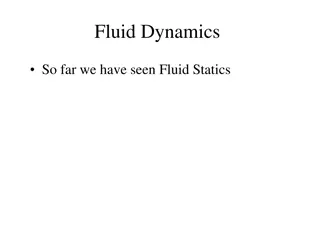
Unveiling the Art of Curveball Pitching in Baseball
Discover the origin, grip, speed, delivery, and impact of the curveball pitch in baseball. Unravel the history behind this iconic pitch, its various nicknames, and how it has become a staple in a pitcher's repertoire. Dive deep into how Candy Cummings revolutionized the game with the invention of the curveball, its unique grip, and the significant impact it has on the game strategy. Understand the nuances of throwing and hitting the curveball, its break, and how it influences managerial decisions in baseball.
Download Presentation

Please find below an Image/Link to download the presentation.
The content on the website is provided AS IS for your information and personal use only. It may not be sold, licensed, or shared on other websites without obtaining consent from the author. If you encounter any issues during the download, it is possible that the publisher has removed the file from their server.
You are allowed to download the files provided on this website for personal or commercial use, subject to the condition that they are used lawfully. All files are the property of their respective owners.
The content on the website is provided AS IS for your information and personal use only. It may not be sold, licensed, or shared on other websites without obtaining consent from the author.
E N D
Presentation Transcript
The Curve Ball A Pitcher s Best Friend
A staple of a pitchers repertoire, the curve is also the most nicknamed pitch in baseball, including as follows: Hook Bender Yakker the traditional catcher s sign two fingers down) Deuce or Number Two (based on
As well as. . . Uncle Charlie exceptionally good ones) Lord Charles (for recently, Yellow Hammer and, most Public Enemy No. 1.
Origins of the Curve According to baseball lore, the curve was invented in the early 1970s by Hall of Famer Candy Cummings. However, descriptions of the pitch appeared in newspapers as early as 1869, and other, mostly collegiate players also became known for it during this time.
According to Cummings, he developed the idea of the curveball after studying the movement sea shells made when thrown. Originally, however, Cummings was unable to throw his curveball, because most catchers stood 20 to 25 feet behind the batter, which made it impossible to field it. Only when his team acquired a catcher who stood directly behind the batter could Cummings throw the pitch.
Grip, Speed, Delivery, and Results: The curveball grip is frequently compared to holding a cup or drinking glass, with the middle finger parallel to one of the long seams, and the thumb behind the seam on the opposite side, so to form a C. The index finger is placed alongside the middle finger.
The delivery of the curveball differs markedly from most other pitches. At the top of the throwing arc, the pitcher snaps the arm and wrist in a downward motion, giving it top spin (as opposed to a fast ball s backspin). The break of the curveball depends upon how hard the pitcher snaps the ball, and how much top spin it has. The curveball is typically thrown much slower than a fastball (an average of 77 MPH in MLB), and so is considered the quintessential offspeed pitch. The curveball generally breaks down, away from a batter that hits from the same side as the pitcher throws. A good MLB curveball will typically break 7 to 20 inches more than the same pitcher s fastball. As a result, right-handed batters generally have a higher BA against left-handed pitchers, and vice versa, which has a considerable influence upon managerial decisions. From a hitter's perspective, the curveball will usually start high or at the top of the strike zone, then dive rapidly as it approaches the plate.
A curveball without much spin will not break much, and is called a hanging curveball that is likely to be deposited in the outfield seats.
By contrast, a well thrown curve ball will leave the batter, rather than the pitcher, embarrassed.
And, giving equal time to righthanders and Astros fans:
The Physics Of The Curveball (or, why I became a lawyer instead of a scientist): The law of physics that make a curveball curve is called the Magnus effect. The raised seams of the ball combines with top spin, air pressure, gravity, and other good stuff. Aw heck, let the professor explain it.
Got that? If not, heres an explanation even us liberal arts majors can understand.
Stand behind a tree 60 feet away, and I will whomp you with an optical illusion!" Does It Really Curve? Early observers questioned whether a curveball actually curved, or was just an optical illusion. In 1949, engineers used wind tunnel tests to prove that it does, indeed, actually curve. Or, you could take the word of Dizzy Dean, who would tell people:
Types Of Curve Balls (and other pitches): The overhand or 12 to 6" curve (typically breaks straight down). The sidearm curve (starts lower and breaks side to side). The slider (usually thrown with a slightly different grip and a stiff wrist, i.e. without the snap. Typically thrown harder, almost like a fastball, with a harder break). The slurve (a combination of the slider and curve).
Compare: the screwball is the reverse of a curveball. The wrist snaps inside, toward the body, rather than outside, away from the body. The result is that the ball breaks in the opposite direction, i.e. a LHP s screwball will break into a left handed batter. Noted practitioners of the screwball include HOFer Carl Hubbell and Fernando Valenzuela.
Compare: the knuckleball, which unlike a curveball that depends on spin, depends on no spin, which allows air currents to carry it in random directions. Because it is thrown with much less speed and involves much less stress on the arm, knuckleball pitchers typically pitch into their 40s. Famous knuckleballers include HOFers Hoyt Wilhelm and Phil Niekro, as well as Tim Wakefield, Wilbur Wood, Charlie Hough, Tom Candiotti, and R.A. Dickey.
Celebrated Curveball pitchers Can you name them?

